

|
|
|
|
|
|
|
|
|
|
|
Photos Scanned And Provided By: Mustafa Pirmohamed
Lindi Notes - Jamat - Muharram
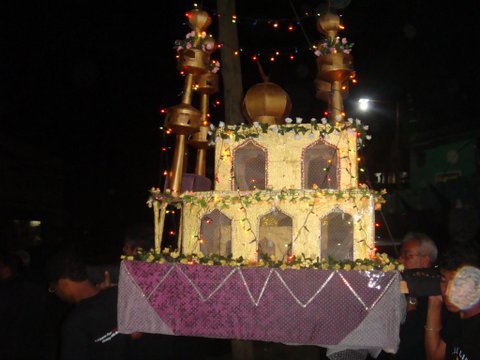
.jpg)
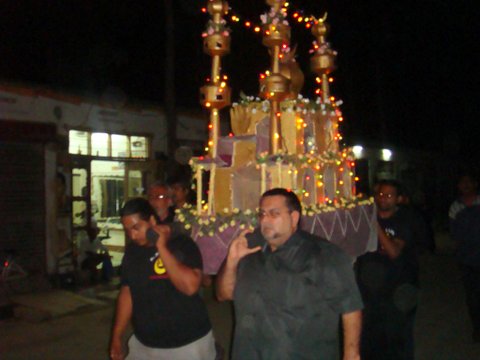
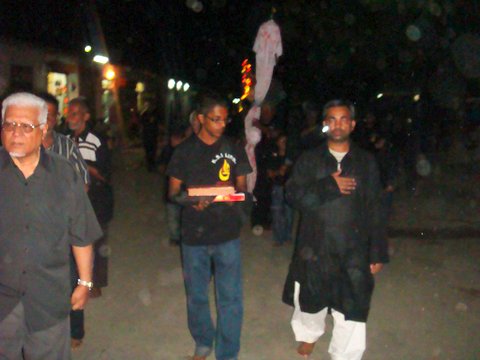
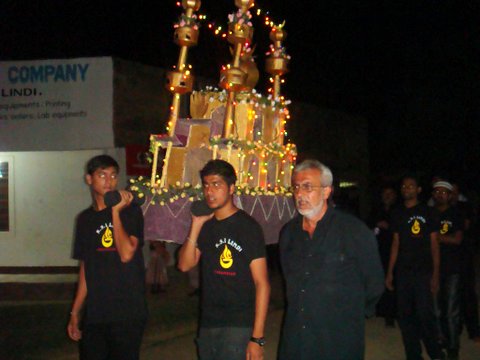
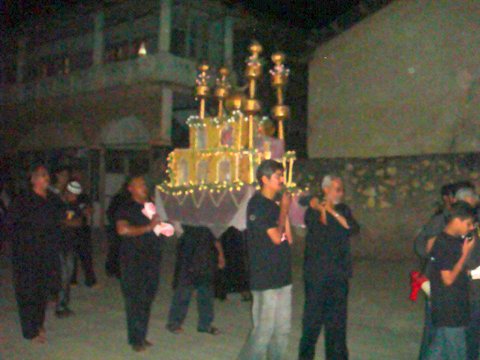
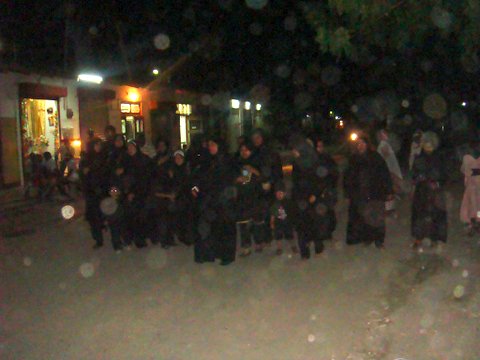
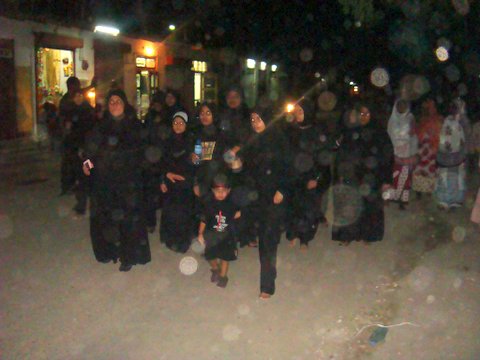
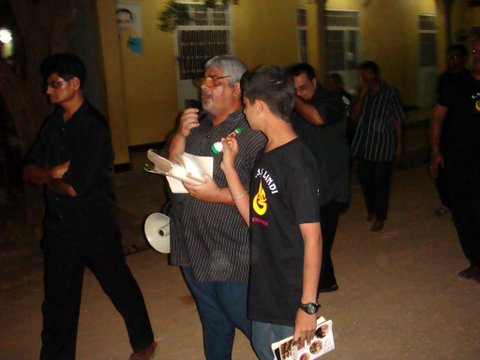
Muharram in Lindi - the
sixties
Muharram meant community members in the surrounding towns and villages coming to Lindi in full force. By full force I mean entire families! You could see the Musafarkhana overflowing with guests. Once I remember some having to be accommodated even at the Madressa – even though the Madressa was just a plain hall.
Imam Hussein a.s. belonged to all Humanity. This was the message we had heard quite often. Attendance at night majlis was heavy. Sunni and Bohora community members also attended. In 40s and 50s an Ismaili family sponsored the main nyaz (meal) on Ashura for many years. Another family always sponsored for the ‘ladu’ of Hazrat Abbas as. We had reciters from other communities too e.g. Adamjee family.
Hussein Day was usually held later in the month of Muharram or the following month. In late fifties and early sixties there was lot of participation by non-community members. Boys used to pick up flowers and festoons, to decorate Madressa and Masjid compound where this occasion was held. Invited members from other communities who attended include the local Liwali, Sheikh Nurdin, Yusuf Lilani, Shyam Thanki, KAJA Hameer, D.C. and other Europeans.
We as kids tended to imitate the sermons and rituals. I have been told some interesting stories about these. In 1930s, my dad would go to the chicken cage downstairs to the ‘uani’ or ‘lawani’ of my home and sit there making the chicken listen to his majlis. While reciting he would hold a stick in the hand. His cousin Fidahussein Abdulrasul was the Salawat announcer. One of the listeners of majlis was my uncle Gulam (now residing in Orlando). Talking of the chicken cage, chicken in those days were unique. Every morning they would be released from their huge cage to go about in neighbourhood. In the evening they would return and be locked in the cage. The chicken released by the neighbour Rashid Versi family would return to their own cages. There wouldn’t be mix-up. The chicken had their own GPS. My late uncle Mohamed used to work at Hassanali Dinani’s warehouse storing simsim (sesame) and other produce. He was fond of keeping chicken although he never had chicken for meal. He would likewise release the chicken from the compound of his warehouse. He once mentioned that one of the chicken had flown over the wall into a neighbour’s house and when he went to enquire, they had already slaughtered it. This was very unusual and surprised everyone in the family.
The kids in the next generation of our family also imitated the Muharram majlis and rituals. In 60s, we also had lash and alam made by ourselves at home and which we moved from one room to another in a procession. We even took from our home to our cousin Hasnein’s apartment nearby through the compound (lawani). Hasnein and Mohamed would also imitate the Maulana. Mohamed would sit on the hard top back of our ancient sofa - imitating the topmost level of the pulpit and recite by mixing up excerpts from what he had heard in majlis. He would do a marvelous job mixing things up and ending up reciting nothing sensible. The most common phrase would be to frequently ask us to eat daaram - pomegranate – as, he claimed, this would lead us to go to Jannat (Heaven). He would take a long stick and fix an empty can to imitate a microphone. He would even copy Late Mohamed Ghadyali who was in charge of the microphone at mosque by trying to adjust the can now and then. Other younger members in the family would sit down to listen attentively. At the end everyone would enjoy eating the fateha (tabarruk) (blessed food).
A week before Muharram, the womenfolk would start dying black the coloured clothes.. A huge ‘sagri’ (charcoal stove) would be prepared with a large sufuria and boiling water. The black dye powder, which we also sold in our shop, would be used. Clothes would then be put in the boiling water and mixed – similar to cooking. The ladies would be careful to make sure that the dye went into each part of the cloth. The clothes would then be dried. This is how we got black clothes those days.
For us boys, there was majlis every morning at the Boarding house, followed by saff matam. Every evening, we would go to Mehfile Abbas – Jumlo’s house – for majlis before proceeding to Kabrastan. Late Gulamhussein Kalyan used to recite majlis at Jumlo house. We used to go to Kabrastan via the rear entrance – if you could call that an entrance. There was no wall at that time and the rear entrance would pass through an open pub with drunkards moving around. In our hearts, we were afraid of the drunkards hitting us. At the same time we also felt that they were too drunk to beat us.
The reason for going through the rear entrance was to pick the guavas, kunazi and furusadi fruits and enjoy them before the majlis started. The majlis was a simple marsiyah – no matam in those days. Late Amiro (Mukhtar Hasham) used to recite “Shaamse jab karbalame aaee Zainul Aabedin’ in a particular manner stretching the last words and winning our hearts. Hasnu bai shiri or Hasnu Bhanji also had a melodious voice. Kids had a common marsia which almost everyone knew to recite: “Jab so gai dar khaane zindaan sakina” This was the shortest marsiya in Masaebe Panjetan – the book which opened “sideways” and which was the only book of Marsiya everyone knew. There were some other books which the good reciters had - like Makhzane Maatam from Zanzibar and other small booklets. Some of the common marsiya recited were:
● “ Mujra use jo kartithi roroke ye takreer, Sughra ko likhu kya”
● “ Laashepe Sakina yehi kehti huyi aayi, hai hai mere ammu”
● “ Sinae Shabbir hai, aur zaanue jallad hai”
● “ Hai salaam uspe jo kehtithi mere bir Husayn”
The month was heralded by volunteers going to the mosque to put the black cloths on the Imambara walls. Several sayings and posters were put on the black kaniki cloth with safety pins. Marhum Ebrahim Esmail (Banura) used to make Alams, by hanging beautiful coloured pachedis from donor ladies. At the end of Safar, the pachedis would be auctioned off by the ladies and proceeds go to the mosque.
Upto 1961, Ashura was also a school holiday at Indian Public School.
After the maghribain prayers at the Husseini Society, there was majlis for boys too. I recited my first and only majlis on one 7th of Safar. Once we had the boys’ evening majalis transferred to Madressa. Don’t know the reason. After majlis we went home for dinner, and hurriedly returned to the mosque to help and observe in preparing Sabeel. The volunteers would go to homes nearby the mosque to go and collect ice which would be used in making the sherbet. People coming for majlis would start by having the sherbet and then go inside to listen to majlis. Sabeel was served twice, while going in and while coming out. There was special badam and milk sherbet on special nights.
As usual, the majlis for the first 5 nights would be followed by bethak matam – matam while sitting. On the 5th and subsequent nights, there would be saff matam. Despite his age, Marhum Rajabali Jaffer Sabodo took part in matam enthusiastically and encouraged others. Late Akberali Kassam Jamhuri would similarly gather all his children in the centre and perform matam vigorously to the amazement of us kids. He also brought Zanjeer with longer blades than anyone else.
Some of the stories about majlis in 1940s are interesting. My father in law, Jafferali Rashid Versi, had mentioned to me about long majlis sermons - 2 to 3 hours each - which were read from books by Mulla Saheb. The session would be interrupted by a break - so that people could go out, refresh themselves, drink water, go to washroom and even smoke outside. They would then return and the session would continue. In those days there was no electricity hence no electric fans. Electricity came to Lindi in 1950. Everyone would have a hand-held fan. The volunteers would also fabricate something akin to wooden louvers all along the ceiling with strings to pull. They would pull and release the louvers - causing a cooling effect. Throughout the majlis, the volunteers’ job would be to pull and release the panels. The pulling would be done from outside the two windows near the main door of the Imambara.
Before the arrival of first resident aalim in late 40s, majlis would be recited by our own local zakirs. Mulla Control (Abdulrasul Remtulla) and Mulla Mehdi Mandazi would read from the book. Mulla Jafferali Nazerali would not use a book and his sermon would be in Gujarati.
There were numerous matam reciters – Mulla M P Daya had a shrill voice – “Shabbir ka Matam chandme hai, Shabbir ka matam tarome” was his famous one. Ebrahim Esmail recited “Haaye Sitam Haayehaa”. In later years, even Mehdi Mandazi and his son Haider recited this one. G G Remtulla brought the whole saff matam to a “josh” by reciting “Ai Momino jab khoon me duba huwa aaaya, Asger ka Janaza”. Mohamed Kamu and Rafiq Ladhu Gulamhussein also recited marsiya before majlis. Hasnu bai shiri (Bhanji) recited many nawha in his melodious voice. Kaburu recited the saff-ending maatam “Haaye Husainaam haaye, nuure do aynaam waay’ Sometimes even after Salawat was recited, youths would continue maatam. Another salawat would be attempted to quiet down everyone but another group would start again. One of the most difficult parts was to stop the matam.
Zanjeer maatam was performed in the small area near the food serving area of gents. I remember Marhum Akberali Abdulla Jaffer reciting “ Islaam ki hai shaan, Husayn ka maatam, Teraso barasse hai dunyame kayam”
Nyaz sessions were full and I remember even the baraza at the serving side was full. I did some volunteering duties in Nyaz but I do not remember why I used my fingers to put kachumbar into every thali that would pass by me. Then at the end of the day my fingers would burn due to the chilli used in Kachumbar. Was there a shortage of spoons? Or spoons were meant only for saag? People ate using their hands anyway. My nyaz friend was Lyakat Jaffer with whom I had nyaz at the end of every session.
Some stories about nyaz in earlier days i.e. 40s and 50s are interesting. Mahum Molu Manji was the famous cook. As usual, those who volunteer for community work sometimes get their share of blames and Molu Manji was no different. Once when people were throwing abuse and criticism, he took his cap and kept it on the ground - open-end upwards, for “receiving” the criticism. When they had all done with their abuse, he took the cap and wore it and telling them – All Done - he was now taking the burden of all that abuse on his head. A simple answer to those critical to him. It is reported that he never got angry. There were many others who volunteered cooking in 60s and later – including Akber Maskini, Gulam Ladhu and Hasnain Babu Kishoto. Bakari is now (2012) main cook.
Mohamed Hameer once reminded me how in those days our sherbet or “juice” consisted of just plain water, colour and sugar. And we drank it with such delight. We had this sherbet in bakudi (aluminium bowls) to be shared between all who were eating from the same thali. Nobody questioned about hygiene those days. In later years, we started having enamel or aluminium cups. Now of course, we have jugs and cups.
After we had our nyaz, we would go back to school for our afternoon session. Most of the time it would be too early for school so we would take the long route to school – via the sea shore.
We did not have juloos (processions) those days. The only one I remember is one which we had on one of the mornings from Boarding House to Mosque – very short one. In 70s, juloos were held from mosque to kabrastan during daytime. In 1990s, the juloos started from Mehfil (home of Late Gulam Khaki) to the mosque on Ashura Night. Nowadays, it starts from the mosque and ends at the mosque.
Ashura night in 60s was a busy night – some even not going home and staying at mosque. We would specially go to the kitchen and see how the Khichdo was being cooked. The men would “songa” (mix) the khichdo in turns and we could see the how they got tired from the amount of energy they were using. On Ashura day, the volunteers had a hectic job of collecting the numerous thalis coming from homes each with rotli and all kinds of daar. This would then be served with the khichro.
Ashura was a sombre day and the busiest day at the mosque. After the majlis, boys carried the laash, alam and julo all together solemnly and the most common nawha would be “Ay Momino uthao Janaza Hussainka” At the end, Marhum Hamza would climb the first step of mimbar and recite Ziyarate Taaziya.
The Muharram of 1965 will be deeply remembered by all friends and colleagues of Marhum Mustafa Jaffer who drowned on the 12th day of Muharram at the age of 14 while swimming at the sea.
| Last updated November 2013 | Copyright © Mahmood Fazal 2005 - All Rights Reserved |
Created By Husain Fazal |